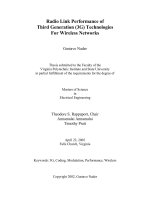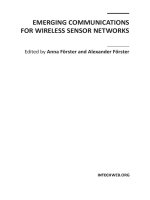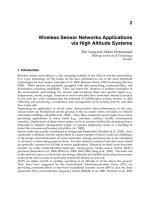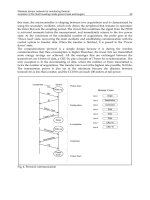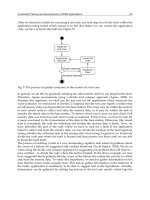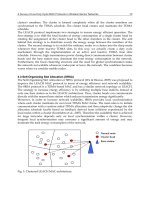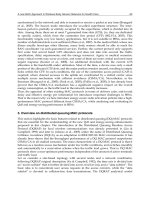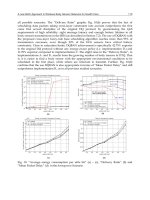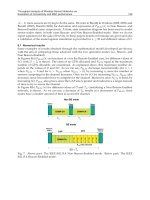GPSR: Greedy Perimeter Stateless Routing for Wireless Networks pps
Bạn đang xem bản rút gọn của tài liệu. Xem và tải ngay bản đầy đủ của tài liệu tại đây (250.73 KB, 27 trang )
1
GPSR: Greedy Perimeter Stateless
Routing for Wireless Networks
B. Karp, H. T. Kung
Borrowed some slides from Richard Yang’s
2
Motivation
❒
A sensor net consists of hundreds or thousands of
nodes
❍
Scalability is the issue
❍
Existing ad hoc net protocols, e.g., DSR, AODV, ZRP,
require nodes to cache e2e route information
❍
Dynamic topology changes
❍
Mobility
❒
Reduce caching overhead
❍
Hierarchical routing is usually based on well defined, rarely
changing administrative boundaries
❍
Geographic routing
• Use location for routing
3
Scalability metrics
❒
Routing protocol msg cost
❍
How many control packets sent?
❒
Per node state
❍
How much storage per node is required?
❒
E2E packet delivery success rate
4
Assumptions
❒
Every node knows its location
❍
Positioning devices like GPS
❍
Localization
❒
A source can get the location of the destination
❒
802.11 MAC
❒
Link bidirectionality
5
Geographic Routing: Greedy Routing
S
D
Closest
to D
A
-
Find neighbors who are the closer to the destination
-
Forward the packet to the neighbor closest to the destination
6
Benefits of GF
❒
A node only needs to remember the location info of one-hop
neighbors
❒
Routing decisions can be dynamically made
7
Greedy Forwarding does NOT always work
❒
If the network is dense enough that each interior node has a
neighbor in every 2Π/3 angular sector, GF will always succeed
GF fails
8
Dealing with Void: Right-Hand Rule
❒
Apply the right-hand rule to traverse the edges of a void
❍
Pick the next anticlockwise edge
❍
Traditionally used to get out of a maze
9
Right Hand Rule on Convex Subdivision
For convex subdivision, right hand rule is equivalent to
traversing the face with the crossing edges removed.
1
0
Right-Hand Rule Does Not Work with
Cross Edges
u
z
w
D
x
x originates a packet to u
Right-hand rule results in the
tour x-u-z-w-u-x
1
1
Remove Crossing Edge
u
z
w
D
x
Make the graph planar
Remove (w,z) from the graph
Right-hand rule results in the
tour x-u-z-v-x
1
2
Make a Graph Planar
Convert a connectivity graph to planar non-crossing graph by
removing “bad” edges
❍
Ensure the original graph will not be disconnected
❍
Two types of planar graphs:
• Relative Neighborhood Graph (RNG)
•
Gabriel Graph (GG)
1
3
Relative Neighborhood Graph
❒
Connection
uv
can exist if
∀
w
≠
u
,
v
,
d
(
u
,
v
) < max[
d
(
u
,
w
),
d
(
v
,
w
)]
not empty
remove uv
1
4
Gabriel Graph
❒
An edge (
u
,
v
) exists between vertices
u
and
v
if no other vertex
w is present within the circle whose diameter is uv.
∀
w
≠
u
,
v
,
d
2
(
u
,
v
) < [
d
2
(
u
,
w
) +
d
2
(
v
,
w
)]
Not empty
remove uv
1
5
Properties of GG and RNG
❒
RNG is a sub-graph of
GG
❍
Because RNG removes more
edges
❒
If the original graph is
connected, RNG is also
connected
RNG
GG
1
6
Connectedness of RNG Graph
❒
Key observation
❍
Any edge on the minimum
spanning tree of the original
graph is not removed
❍
Proof by contradiction: Assume
(u,v) is such an edge but removed in RNG
u
v
w
1
7
•
200 nodes
•
randomly placed on a 2000 x 2000 meter region
• radio range of 250 m
•Bonus: remove redundant, competing path less collision
Full graph GG subset RNG subset
Examples
1
8
Greedy Perimeter Stateless Routing (GPSR)
❒
Maintenance
❍
all nodes maintain a single-hop neighbor table
❍
Use RNG or GG to make the graph planar
❒
At source:
❍
mode = greedy
❒
Intermediate node:
❍
if (mode == greedy) {
greedy forwarding;
if (fail) mode = perimeter;
}
if (mode == perimeter) {
if (have left local maxima) mode = greedy;
else (right-hand rule);
}
1
9
GPSR
Greedy Forwarding Perimeter Forwarding
greedy fails
have left local maxima
greedy works
greedy fails
2
0
Implementation Issues
❒
Graph planarization
❍
RNG & GG planarization depend on having the current location info
of a node’s neighbors
❍
Mobility may cause problems
❍
Re-planarize when a node enters or leaves the radio range
• What if a node only moves in the radio range?
•
To avoid this problem, the graph should be re-planarize
for every beacon msg
❍
Also, assumes a circular radio transmission model
❍
In general, it could be harder & more expensive than it sounds
2
1
Performance evaluation
❒
Simulation in ns-2
❒
Baseline: DSR (Dynamic Source Routing
❒
Random waypoint model
❍
A node chooses a destination uniformly at random
❍
Choose velocity uniformly at random in the configurable range –
simulated max velocity 20m/s
❍
A node pauses after arriving at a waypoint – 300, 600 & 900 pause
times
2
2
❒
50, 112 & 200 nodes
❍
22 sending nodes & 30 flows
❍
About 20 neighbors for each node – very dense
❍
CBR (2Kbps)
❒
Nominal radio range: 250m (802.11 WaveLan radio)
❒
Each simulation takes 900 seconds
❒
Take an average of the six different randomly generated
motion patterns
2
3
Packet Delivery Success Rate
2
4
Routing Protocol Overhead
2
5
Related Work
❒
Geographic and Energy Aware Routing (GEAR), UCLA Tech
Report, 2000
❍
Consider remaining energy in addition to geographic location to
avoid quickly draining energy of the node closest to the
destination
❒
Geographic probabilistic routing, International workshop on
wireless ad-hoc networks, 2005
❍
Determine the packet forwarding probability to each neighbor
based on its location, residual energy, and link reliability
